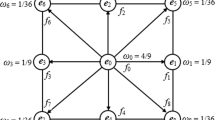Abstract
The present study has numerically investigated two-dimensional flow over three circular cylinders in an equidistant side-by-side arrangement at a low Reynolds number. For the study, numerical simulations are performed, using the immersed boundary method, in the range ofg* < 5 at Re=100, whereg* is the spacing between two adjacent cylinder surfaces divided by the cylinder diameter. Results show that the flow characteristics significantly depend on the gap spacing and a total of five kinds of wake patterns are observed over the range: modulationsynchronized (g*≥2), inphase-synchronized(g*≈l.5), flip-flopping (0.3<g*≲1.2), deflected (g*≈0.3), and single bluff-body patterns (g*<0.3). Moreover, the parallel and symmetric modes are also observed depending ong* in the regime of the flip-flopping pattern. The corresponding flow fields and statistics are presented to verify the observations.
Similar content being viewed by others
Abbreviations
- Cd, Cl:
-
drag and lift coefficients
- d :
-
cylinder diameter
- g, g*(=g/d) :
-
gap spacing
- M, N :
-
spatial resolution
- p :
-
pressure
- Re :
-
Reynolds number
- St :
-
Strouhal number
- t :
-
time
- ui, (u, v):
-
velocity components
- u∞:
-
free-stream vlocity
- xi, (x, y):
-
Cartesian coordinates
- Δ:
-
increment
- —:
-
time-average
- ’:
-
fluctuation
- γms :
-
root mean square
- i :
-
indices (l, 2, 3)
References
Eastop, T. D. and Turner, J. R., 1982, “Air Flow around Three Cylinders at Various Pitch- to-Diameter Ratios for Both a Longitudinal and a Transverse Arrangement,”Trans. Inst. Chem. Eng., Vol.60, pp. 359–363.
Guillaume, D. W. and LaRue, J. C., 1999, “Investigation of the Flopping Regime with Two-, Three- and Four-Cylinder Arrays,”Exp. Fluids, Vol.27, pp. 145–156.
Ishigai, S. and Nishikawa, E., 1975, “Experimental Study of Gas Flow in Tube Banks with Tube Axes Normal to Flow Part II; on the Structure of Gas Flow in Single-Column, Single- Row, and Double-Rows Tube Banks,”Bull JSME, Vol. 18, pp. 528–535.
Kang, S., 2003, “Characteristics of Flow over Two Circular Cylinders in a Side-by-Side Arrangement at Low Reynolds Numbers,”Phys. Fluids, Vol. 15, pp. 2486–2498.
Kim, H. J. and Durbin, P. A., 1988, “Investigation of the Flow between a Pair of Circular Cylinders in the Flopping Regime,”J. Fluid Mech., Vol. 196, pp. 431–448.
Kim, J., Kim, D., and Choi, H., 2001, “An Immersed-Boundary Finite-Volume Method for Simulations of Flow in Complex Geometries,”J. Comput. Phys., Vol. 171, pp. 132–150.
Kumada, M., Hiwada, M., Ito, M., and Mabuchi, I., 1984, “Wake Interference between Three Circular Cylinders Arranged Side by Side Normal to a Flow,”Trans. JSME, Vol. 50, pp. 1699- 1707 (in Japanese).
Le Gal, P., Peschard, I., Chauve, M. P., and Takeda, Y., 1996, “Collective Behavior of Wakes Downstream a Row Cylinders,”Phys. Fluids, Vol.8, pp. 2097–2106.
Moretti, P. M. and Cheng, M., 1987, “Instability of Flow through Tube Rows,”J. Fluids Eng., Vol. 109, pp. 197–198.
Park, J., Kwon, K., and Choi, H., 1998, “Numerical Simulations of Flow past a Circular Cylinder at Reynolds Numbers up to 160,”KSME Int. J., Vol. 12, pp. 1200–1205.
Sumner, D., Wong, S. S. T., Price, S. J., and PaΪdoussis, M. P., 1999, “Fluid Behavior of Side- by-Side Circular Cylinders in Steady Cross-Flow,”J. Fluids Struct., Vol. 13, pp. 309–338.
Williamson, C. H. K., 1985, “Evolution of a Single Wake behind a Pair of Bluff Bodies,”J. Fluid Mech., Vol. 159, pp. 1–18.
Williamson, C. H. K., 1989, “Oblique and Parallel Modes of Vortex Shedding in the Wake of a Circular Cylinder at Low Reynolds Numbers,”J. Fluid Mech., Vol. 206, pp. 579–627.
Zdravkovich, M. M. and Stonebanks, K. L., 1990, “Intrinsically Nonuniform and Metastable Flow in and between Tube Arrays,”J. Fluids Struct., Vol. 4, pp. 305–319.
Zhang, H.J. and Zhou, Y., 2001, “Effect of Unequal Spacing on Vortex Streets behind Three Side-by-Side Cylinders,”Phys. Fluids, Vol. 13, pp. 3675–3686.
Zhou, Y., So, R. M. C., Liu, M. H., and Zhang, H. J., 2000, “Complex Turbulent Wakes Generated by Two and Three Side-by-Side Cylinders,”Int. J. Heat Fluid Flow, Vol. 21, pp. 125- 133.
Zhou, Y., Zhang, H. J., and Yiu, M. W., 2002, “The Turbulent Wake of Two Side-by-Side Circular Cylinders,”J. Fluid Mech., Vol. 458, pp. 303–332.
Author information
Authors and Affiliations
Corresponding author
Rights and permissions
About this article
Cite this article
Kang, S. Numerical study on laminar flow over three side-by-side cylinders. KSME International Journal 18, 1869–1879 (2004). https://doi.org/10.1007/BF02984335
Received:
Revised:
Issue Date:
DOI: https://doi.org/10.1007/BF02984335



